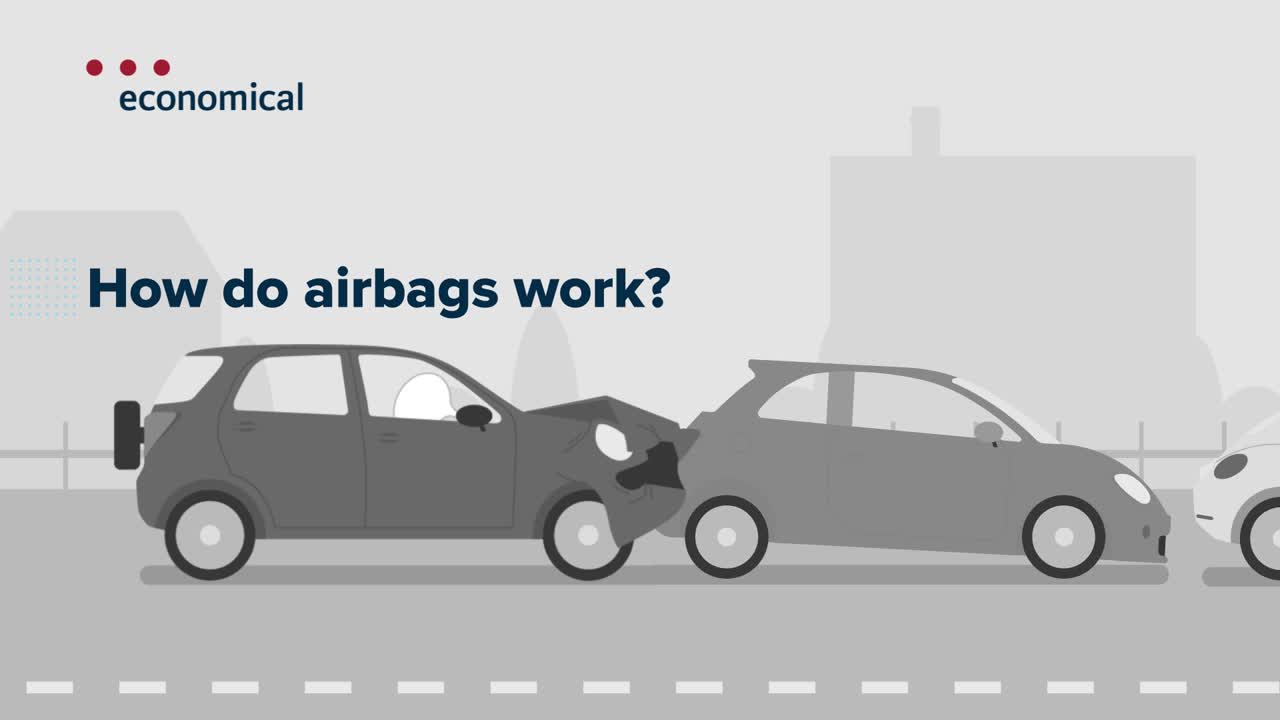If your vehicle was built in or after the nineties, it probably has airbags. Even if you've never seen yours in action, have you ever found yourself wondering how they actually work? Take some time to consider the facts and learn about three simple steps you can take to prevent airbag injuries, so you and your passengers can stay safe on the road.
How do airbags work?
Airbags are built into the steering wheel, dashboard, and the side panels of a vehicle, and they're designed to protect your head and upper body from colliding with the windshield, dashboard, or steering wheel when you're in an accident. So, what makes airbags kick in? And what happens next?
When you're involved in a collision, your airbag deploys in a split second. Let's take a look at how it works in slow-motion:

An airbag deploys in a split second. Let’s slow it down a little.
When your car hits something, it decelerates very quickly…which is detected by your vehicle’s accelerometer. If you decelerate quickly enough, the accelerometer triggers the airbag circuit. The airbag circuit passes an electric current through a heating element…which ignites a chemical explosive that fills the airbag with a (harmless) gas. As it inflates, the airbag bursts out of its cover…just in time to stop you from slamming into a hard surface in your vehicle. The airbag automatically deflates through built-in air vents once you’ve hit it. It should be totally deflated by the time your car stops moving.
A lot happens in a split second. Drive safely out there.
Now, let’s break down the process in a little more detail:
- When your car hits something, it decelerates (or loses speed) very quickly, which is detected by the vehicle's accelerometer (a sensor that measures acceleration).
- If your rate of deceleration reaches a certain threshold, the sensor triggers the airbag circuit. While this threshold varies depending on your vehicle's model, the impact is usually equivalent to crashing into a wall at 13 to 23 km/h — a much stronger force than you could generate by hitting the brake pedal.
- The airbag circuit passes an electrical current through a heating element (imagine the glowing wires in your toaster), which ignites a chemical explosive, creating a harmless gas that fills up the airbag.
- As the airbag expands, it bursts out of its cover just in time to stop you from slamming into a not-so-cushy surface in your vehicle.
- The airbag automatically releases its air through built-in vents to prevent suffocation. It should be completely deflated by the time your car stops moving.
Not all airbags are created equal, and they differ in design and the way they perform. You can learn about the features of your own car's airbags by contacting the manufacturer or reading your owner's manual — and be sure to keep up with current airbag recalls by checking Transport Canada’s database.
How to prevent common airbag injuries
The force of an airbag is strongest in the first 8 cm after it bursts through its cover and starts to inflate, so anyone who is sitting too close to it when it launches could be seriously injured. While airbags are designed to protect you in the event of a collision, it's important that everyone in your car wears a seatbelt and sits far enough away from the airbags that they only come into contact with them once they're fully inflated.
To keep yourself and your passengers safe on the road, take these three simple steps towards airbag safety:
- Sit back. Keep your driver's seat as far back as you can (ideally at least 25 cm away from the airbag) while maintaining a safe driving position. You should still be far enough forward that you can grip the steering wheel with two hands and apply pressure on both pedals without having to move your body away from the back of your seat. The passenger seat should always be kept as far back as possible, and passengers should keep their feet and other objects off the dashboard.
- Buckle up.Before you shift your car into drive, make sure every passenger is wearing a seatbelt. The lap belt should fit snugly over your hips (not around your stomach), and the shoulder belt should be pulled tight across your chest and over your shoulder. In a collision, your seatbelt will slow down your movement and give the airbag a chance to inflate before you hit it.
- Think of the kids. Most provinces and territories recommend that all kids under 13 years old ride in the back seat to keep them safe in a collision, especially when your car has airbags. Never strap a rear-facing car-seat in the front seat when your airbags are active. To learn more about keeping your kids safe on the road, check out the Government of Canada’s car seat safety guidelines.
Although they're designed to prevent serious injuries and death, airbags can cause minor injuries like bruises, cuts, or scrapes. But when used correctly, the positive effects afforded by airbags far outweigh the minor bumps and bruises they bring with them.
Your vehicle's airbags are just one of many advanced safety features that come standard in modern builds. But don't forget that other features like back-up cameras and winter tires can help you stay on track and prevent collisions before they happen. If you're thinking of upgrading to a vehicle with more up-to-date safety features, be sure to talk to your group's insurance broker before taking your new car for a spin.
Share this article on Facebook or Twitter to help other drivers learn how airbags work.